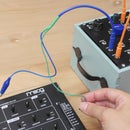Introduction: DIY Robe Coat - With Pattern!
This is a coat that is super comfortable, easy to wear and easy(ish) to make. It's pattern is modeled after a robe, it includes a shawl collar, patch pockets, it doesn't have any closures and instead has a belt that you loosely tie around the waist.
Robe coats are all over the Fall runway and a really great, simple sewing project that looks impressive after completion.
This jacket is made of boiled or felted wool, so no hemming is needed and the included pattern consists of 4 pieces. This project is for people who have some experience, but it's not advanced. There are two potentially tricky parts to this project, but I'm confident that if you have even just looked at a sewing machine, you can make this.
The pattern is a size 8
*For the more advanced seamstress - this project calls for 2 yards, if you want to lengthen your coat, make sure to grab 2.5 - 3 yards.
Step 1: Gather Materials
- 2 yards of 60" width boiled wool **
- matching thread
- printed and taped together pattern (included below)
- tailor's chalk
- measuring tape
- graph ruler
- pins or pattern weights
- rotary cutter and/or scissors
- sewing machine
- seam ripper
- awl (optional)
** Note of Fabric
Boiled or felted wool is what you want to use because there will be no finishing or hemming. When wool is felted (either by boiling, needles, etc.), the edges can be cut with little to no fraying.
Attachments
Step 2: Print and Prep Pattern
Print out the pattern that is attached to the previous step. The full pattern pieces are tiled for you. Tape them edge to edge, with no overlap. Images of the full pattern pieces are included for your reference.
Full pattern pieces are:
- FRONT
- BACK
- SLEEVE
Lay the pages out, working clock-wise from top left corner.
Page number 1 of each pattern piece is the top left. The last page is the bottom left.
Tape together and cut along the outside line. The pages will have a .25" border, unless you have your printer preferences set to something else.
Pattern includes:
Grainline
Marked 3/8" seam allowance (SA)
Punch holes are circled
Pattern piece name
How many to cut
Armhole and sleeve notches
Step 3: Cut Fabric Pattern
► Use a seam ripper, pin or awl to punch holes for the pocket placement on the FRONT and the bust dart. The punches are in the middle of each of the circles.
► Fold the fabric in half lengthwise so two pattern pieces can be cut at once and mirrored. The fabric I used had large horizontal stripes, so I took care to line up the FRONT and BACK pieces so the stripes aligned once folded. Place the pattern pieces, running your grainline parallel to the fabric's selvage. To match the stripes at the side seam, I lined up the underarm and bottom hem point of the FRONT and BACK so they were even with each other and so the side seams were running parallel to one another.
If you don't have to worry about matching a pattern, place the pieces so the least amount of fabric is wasted. Pin or weight down.
► Cut each piece following the cut amount on each pattern piece.
FRONT - cut 2
BACK - cut 2
SLEEVE - cut 2
POCKET - cut 2
► Before removing each pattern piece, clip in 1/8" - 1/4" at each notch.
2 for the front dart
1 on top of armhole, marking where to line up the shoulder seam
1 on front armhole
2 on back armhole
► Using tailor's chalk mark each punch hole for the pocket placement and bust dart. Make sure to mark both FRONT pieces!
► If you have stripes to match:
Lay the FRONT piece parallel to a scrap of fabric big enough to cut the pocket from. Next, lay the top edge of your ruler 3/8" from the top of the punch hole marks, this takes 3/8" SA into account. Extend the length of the ruler over the scarp piece of fabric. Match and line up the stripes, place the top edge of the POCKET pattern below the edge of the ruler and cut. Check out the photo for reference.
Step 4: Sew Front Darts and Pockets
► Start sewing with the front darts. Fold dart in half along chalk mark and matching up notches. Pin and sew starting at notches and ending 1/2" past mark. Back stitch or tie off. Repeat on second front piece.
► Press darts downward
►Place pocket on the right side of the front, lining up markings. Pin and sew 1/4" from raw edge, make a right angle at the top, this reinforces the pocket corners and helps prevent damage through wear and tear.
Step 5: Shoulder, Neckline and Side Seam
This is the first thing in this project that can be a bit tricky. There is a pivot point and some clipping where the shoulder meets the neckline as you sew. It's not difficult once you get comfortable with manipulating the fabric beneath your sewing machine. It will feel wrong, but once you match the edges, sew and clip. You will see the light :)
► Mark the corner of the shoulder point that meets the neckline
► Sew the shoulder starting from the outside going towards the neck and ending with your needle down through the fabric on the mark.
► With the needle down, lift up your presser foot and sweep the back collar down, matching the raw edges of the back neckline with the collar. The fabric will pucker, we will take care of that in the next step.
► After the shoulder and neck are sewn, clip the FRONT SA at the pivot point where it is pulling. Don't clip too close, leave 1/8" from seam. This frees up the fabric to spread out and lay flat. Press the seam and survey your work!
Step 6: Sew Back Seam
► Pin the two sides together along the back seam, right side to right side. Sew at 3/8", press.
► Press flat the center collar seam and top stitch the SA down 1/8" from edge.
► You have completed the body of the jacket with a built in shawl collar.
Step 7: Setting in the Sleeves
The sleeve of this pattern does not have any ease, because there wasn't much of a need for a rounded shoulder. However, I still used the technique for easing in sleeve to help set the curve of the sleeve cap in the armhole.
► Sew sleeves up the underarm seam with right sides together, press open seam and turn inside-out.
► Put your sewing machine on it's longest stitch length (basting stitch) and sew no more than a 1/4" from edge along the sleeve cap from one notch to the next. Do not back stitch, leave the thread ends loose. Pull the ends of the thread to make little gathers along the curve of the cap. There isn't any ease patterned in, but this still helps fit the sleeve in, since it's on the inside of the armhole.
Here is an instructable on how to sew a set-in sleeve with ease.
► Pin the sleeve into the armhole, right side to right side, matching up shoulder seam with top notch on sleeve cap, front and back notches and evenly pinning and distributing the sleeve cap and rest of the sleeve cap.
► Sew in sleeve, go slowly to make sure that you don't sew pinches in the fabric.
► Turn inside-out and check out the work, setting in sleeves sometimes takes reworking. If you have a little pinch, use a seam ripper to take out the tuck and a few stitches on either side. Smooth out, pin and resew. Press and steam the seam when done.
► Turn up the cuffs and press.
Step 8: Belt and Belt Loops
You are almost done! By this time you should of modeled the jacket at least once or twice ;)
You can also try it on, use your chalk to make any adjustments and nip in hear and there if you need.
Belt
► Cut two strips that are 2.5" wide and 36" long. The grain line can go parallel or be on the cross grain, which ever fits best for you.
► Sew them together to double the length
► Press the seam open and, like the collar seam, stitch SA down.
► Top stitch 1/4" from edge all around the belt, this helps keep the belt from stretching out over time.
Belt Loops
► Cut two pieces of fabric 3/4" wide and 4.25" long.
► Like on the belt, stitch around the perimeter, 1/8" in from edge.
► Mark 1/2" with chalk from both ends and loop
► Mark 4" down from underarm, this is where the waistline is patterned in, you can play with where you want your belt loops before sewing if you want. Line up the 1/2" mark with the 4" mark, pin and sew.
► Fold down 1/2" on the other loop's end, fold down the whole loop, pin and topstitch.
► Repeat on the other side. Feel free to add a center back loop!

Participated in the
Wear It! Contest














